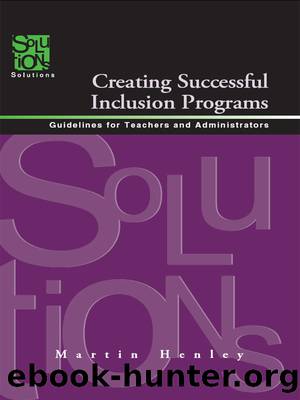Creating Successful Inclusion Programs by Henley Martin;

Author:Henley, Martin;
Language: eng
Format: epub
Publisher: Solution Tree
Published: 2011-08-15T00:00:00+00:00
Chapter 5
Inclusive Teaching
LIKE PROSPECTORS SEARCHING FOR PRECIOUS STONES, educators are always searching for the best way to teach. And educators strive like prospectors to discriminate between foolâs gold and the real thing. Many claims are staked about the best way to teachâwhole language, phonics, direct instruction, constructivism, cooperative learning, computer-assisted instruction, learning styles, drill and repetition, multisensory instruction ⦠the list goes on and on. Yet for every teacher who strikes gold with a particular method, there is another one who goes bust.
Several years ago, I attended a meeting of special education college faculty and public school special education administrators. The administrators had some very specific complaints about new teachers. An administrator of a large urban school system was particularly unhappy with preservice training. He said, âEvery year I have to train our new teachers in the Orton-Gillingham method. We use Orton-Gillingham to teach our students with learning disabilities, and Iâm tired of doing the collegesâ job.â Many of my higher-education colleagues exchanged bemused glances. One instructional approach for that cityâs 3,700 students with learning disabilities seemed more like foolâs gold than a shining example of individualized instruction.
Whenever someone asks me what is the best way to teach special education students, I think of the special education administrator who believed so fervently in the Orton-Gillingham approach. The Orton-Gillingham method was developed by a neurosurgeon to teach students with dyslexia. It is based on the premise that phonics is best taught through a combination of multisensory (visual, auditory, tactile, and kinesthetic) methods and systematic teacher instructionâa pretty good approach for some students; however, not all students with learning disabilities have dyslexia, nor do all students with learning disabilities succeed with the Orton-Gillingham method.
With all the claims and counterclaims about the best way to teach, how can a teacher decide what instructional approach is best? The research on this question is clear: Effective teaching methods are judged by the level of student participation (Brophy & Good, 1986). Simply put, students who are actively engaged in their learning succeed; those who are not, struggle. Engaged learning refers to explicit student behavior that indicates that students are thinking. Creative writing, brainstorming, contrasting ideas, creating projects, interacting with other students, and participating in teacher-student dialogue are examples of engaged learning. Although silent reading, oral reading, looking up answers to textbook questions, listening to teacher lectures, independent seat work, copying notes, and doing worksheets are commonplace activities, these are not necessarily engaged behaviors because they require little thought. Figure 5.1 shows methods of inclusive instruction that are more and less effective.
Download
This site does not store any files on its server. We only index and link to content provided by other sites. Please contact the content providers to delete copyright contents if any and email us, we'll remove relevant links or contents immediately.
The Art of Coaching Workbook by Elena Aguilar(48340)
Trainspotting by Irvine Welsh(20085)
Twilight of the Idols With the Antichrist and Ecce Homo by Friedrich Nietzsche(17722)
Fangirl by Rainbow Rowell(7844)
Periodization Training for Sports by Tudor Bompa(7342)
Change Your Questions, Change Your Life by Marilee Adams(6658)
This Is How You Lose Her by Junot Diaz(5800)
Grit by Angela Duckworth(4747)
Red Sparrow by Jason Matthews(4686)
Asking the Right Questions: A Guide to Critical Thinking by M. Neil Browne & Stuart M. Keeley(4600)
Paper Towns by Green John(4178)
Room 212 by Kate Stewart(4116)
Ken Follett - World without end by Ken Follett(3984)
The Sports Rules Book by Human Kinetics(3597)
Housekeeping by Marilynne Robinson(3421)
The Motorcycle Diaries by Ernesto Che Guevara(3345)
Introduction to Kinesiology by Shirl J. Hoffman(3306)
Exercise Technique Manual for Resistance Training by National Strength & Conditioning Association(3299)
Double Down (Diary of a Wimpy Kid Book 11) by Jeff Kinney(3286)
